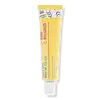What's inside
What's inside
 Key Ingredients
Key Ingredients

 Benefits
Benefits

 Concerns
Concerns

No concerns
 Ingredients Side-by-side
Ingredients Side-by-side

Water
Skin ConditioningPropanediol
SolventButylene Glycol
HumectantGlycerin
Humectant1,2-Hexanediol
Skin ConditioningSodium Polyacryloyldimethyl Taurate
Emulsion StabilisingCetyl Ethylhexanoate
EmollientCorn Starch Modified
AbsorbentIlex Paraguariensis Leaf Extract
PerfumingCetearyl Olivate
Sorbitan Olivate
EmulsifyingPanthenol
Skin ConditioningAllantoin
Skin ConditioningAdenosine
Skin ConditioningTocopherol
AntioxidantHelianthus Annuus Seed Oil
EmollientHydrolyzed Hyaluronic Acid
HumectantSodium Hyaluronate
HumectantHyaluronic Acid
HumectantCaffeine
Skin ConditioningAcetyl Tetrapeptide-5
HumectantCichorium Intybus Root Extract
MaskingWater, Propanediol, Butylene Glycol, Glycerin, 1,2-Hexanediol, Sodium Polyacryloyldimethyl Taurate, Cetyl Ethylhexanoate, Corn Starch Modified, Ilex Paraguariensis Leaf Extract, Cetearyl Olivate, Sorbitan Olivate, Panthenol, Allantoin, Adenosine, Tocopherol, Helianthus Annuus Seed Oil, Hydrolyzed Hyaluronic Acid, Sodium Hyaluronate, Hyaluronic Acid, Caffeine, Acetyl Tetrapeptide-5, Cichorium Intybus Root Extract
Water
Skin ConditioningPropylene Glycol
HumectantGlycerin
HumectantOryza Sativa Hull Powder
AbrasiveAmmonium Acryloyldimethyltaurate/Vp Copolymer
Sclerotium Gum
Emulsion StabilisingDiazolidinyl Urea
PreservativeSodium Benzoate
MaskingSodium PCA
HumectantDisodium EDTA
Sodium Lactate
BufferingPotassium Sorbate
PreservativeArginine
MaskingAspartic Acid
MaskingHydrolyzed Wheat Protein
Skin ConditioningPCA
HumectantCentaurea Cyanus Flower Extract
AstringentLinum Usitatissimum Seed Extract
PerfumingHydrolyzed Hyaluronic Acid
HumectantGlycine
BufferingAlanine
MaskingAesculus Hippocastanum Seed Extract
Skin ConditioningSerine
MaskingValine
MaskingLinalool
PerfumingCaramel
Cosmetic ColorantThreonine
Isoleucine
Skin ConditioningProline
Skin ConditioningParfum
MaskingAnthemis Nobilis Flower Oil
MaskingLavandula Angustifolia Oil
MaskingLavandula Hybrida Oil
EmollientOsmanthus Fragrans Flower Extract
MaskingPhenoxyethanol
PreservativeHistidine
HumectantPhenylalanine
MaskingSodium Hydroxide
BufferingPadina Pavonica Thallus Extract
Skin ConditioningWater, Propylene Glycol, Glycerin, Oryza Sativa Hull Powder, Ammonium Acryloyldimethyltaurate/Vp Copolymer, Sclerotium Gum, Diazolidinyl Urea, Sodium Benzoate, Sodium PCA, Disodium EDTA, Sodium Lactate, Potassium Sorbate, Arginine, Aspartic Acid, Hydrolyzed Wheat Protein, PCA, Centaurea Cyanus Flower Extract, Linum Usitatissimum Seed Extract, Hydrolyzed Hyaluronic Acid, Glycine, Alanine, Aesculus Hippocastanum Seed Extract, Serine, Valine, Linalool, Caramel, Threonine, Isoleucine, Proline, Parfum, Anthemis Nobilis Flower Oil, Lavandula Angustifolia Oil, Lavandula Hybrida Oil, Osmanthus Fragrans Flower Extract, Phenoxyethanol, Histidine, Phenylalanine, Sodium Hydroxide, Padina Pavonica Thallus Extract
 Reviews
Reviews

Ingredients Explained
These ingredients are found in both products.
Ingredients higher up in an ingredient list are typically present in a larger amount.
Glycerin is already naturally found in your skin. It helps moisturize and protect your skin.
A study from 2016 found glycerin to be more effective as a humectant than AHAs and hyaluronic acid.
As a humectant, it helps the skin stay hydrated by pulling moisture to your skin. The low molecular weight of glycerin allows it to pull moisture into the deeper layers of your skin.
Hydrated skin improves your skin barrier; Your skin barrier helps protect against irritants and bacteria.
Glycerin has also been found to have antimicrobial and antiviral properties. Due to these properties, glycerin is often used in wound and burn treatments.
In cosmetics, glycerin is usually derived from plants such as soybean or palm. However, it can also be sourced from animals, such as tallow or animal fat.
This ingredient is organic, colorless, odorless, and non-toxic.
Glycerin is the name for this ingredient in American English. British English uses Glycerol/Glycerine.
Learn more about GlycerinHydrolyzed Hyaluronic Acid is a form of hyaluronic acid. It is created by the hydrolysis of hyaluronic acid with a high molecular weight. Once created, Hydrolyzed Hyaluronic Acid has a low molecular weight.
Low molecular weight HA has been shown to hydrate and increase elasticity of the skin. Increasing elasticity is also associated with reduction of wrinkle depth.
One study found topical low molecular weight hyaluronic acid may be considered for the treatment of rosacea in the adult population. However, we always recommend speaking with a professional about your skin concerns.
Hyaluronic acids are a humectant. This means they draw moisture from the air. Hyaluronic acids help moisturize, soothe, and protect the skin.
Read more about other common forms of hyaluronic acid:
Learn more about Hydrolyzed Hyaluronic AcidWater. It's the most common cosmetic ingredient of all. You'll usually see it at the top of ingredient lists, meaning that it makes up the largest part of the product.
So why is it so popular? Water most often acts as a solvent - this means that it helps dissolve other ingredients into the formulation.
You'll also recognize water as that liquid we all need to stay alive. If you see this, drink a glass of water. Stay hydrated!
Learn more about Water